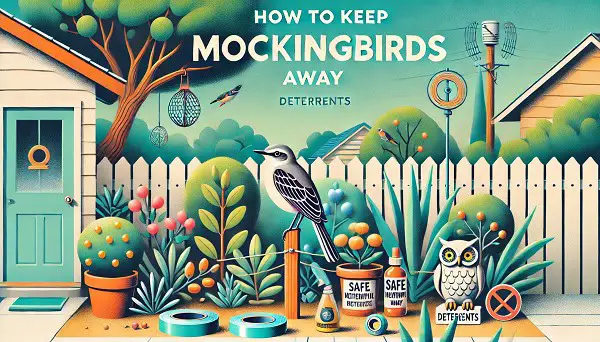How to Keep Mockingbirds Away: A Complete Guide
Mockingbirds are fascinating birds, known for their ability to mimic sounds and sing a repertoire of tunes. However, they quickly go from charming to annoying when they start invading your backyard, stealing cat food, and bullying other birds around feeders. If you’re dealing with these feathered intruders, don’t worry—there are effective ways to discourage them from hanging around. Here’s a comprehensive guide on keeping mockingbirds away from your home, feeders, plants, and pets.
How to Keep Mockingbirds Away from Feeders
Mockingbirds love feeders, especially if they find tasty morsels like seeds, suet, and fruit. But they’re also territorial and can scare away other bird species you might want to attract. Here’s how to keep them at bay:
- Switch the Feed: Mockingbirds love fruit, suet, and mealworms. Try using seed mixes mockingbirds aren’t interested in, like safflower seeds. They’re not fond of these, but other birds, like cardinals, enjoy them.
- Install a Caged Feeder: Some feeders have cages around them that allow smaller birds to feed while keeping out larger ones, including mockingbirds. Caged feeders also protect finches, chickadees, and sparrows from aggressive visitors.
- Location, Location, Location: Mockingbirds are bold but prefer to feed in open areas. Placing your feeders closer to shrubs or trees (not in the open) might make them less attractive to mocking birds.
- Add Decoys: Surprisingly, placing a decoy owl or hawk near your feeder can scare off mockingbirds. These birds are wary of predators, so they might avoid an area that appears dangerous.
Quick Tip: If you’re okay with a bit of noise, playing predator bird calls on a small speaker near the feeder can sometimes be effective in discouraging mocking birds from approaching.
How to Keep Mockingbirds Away from Tomato Plants
Mockingbirds are notorious for raiding gardens, especially regarding juicy fruits like tomatoes. Here’s how to protect your prized produce:
- Use Bird Netting: Bird netting is a simple and effective way to keep mockingbirds away from tomatoes. Drape the netting over your plants, securing it at the edges so birds can’t sneak underneath. This provides a physical barrier but keeps the netting taut so birds don’t get tangled.
- Place Reflective Objects Around the Garden: Mockingbirds dislike reflective objects. Hang strips of aluminum foil, old CDs, or even reflective tape around the tomato plants. The glinting light can deter them from approaching.
- Install Motion-Activated Sprinklers: For a more high-tech solution, motion-activated sprinklers scare birds (and other animals) away with a harmless burst of water. This method effectively keeps mockingbirds and other potential pests off your plants.
- Provide Alternative Food Sources: Sometimes, mockingbirds raid tomatoes simply because they’re hungry or thirsty. Setting up a birdbath or a feeder with seeds or fruit away from your garden can help divert their attention from your plants.
Related How To Keep Birds From Nesting in Gutters?
How Do You Keep Mockingbirds Away from Bluebirds?
Mockingbirds can be aggressive toward other birds, particularly around nesting areas. If you’re hoping to create a safe haven for bluebirds, here are some tricks:
- Place Bluebird Houses in Strategic Locations: Set up bluebird houses in areas out of mockingbirds’ preferred range, ideally in more open spaces, as mockingbirds usually prefer areas with dense shrubs or trees.
- Limit Nesting Opportunities for Mockingbirds: Mockingbirds are likelier to stick around if they have a place to nest. Trim back shrubs and trees close to bluebird houses to reduce appealing nesting spots for them.
- Use Decoy Feeders: Setting up an alternative feeding area for mockingbirds—preferably away from the bluebird house—can help keep them busy. Include fruit like grapes or berries in the decoy feeder to attract the mockingbirds elsewhere.
Did You Know? Mockingbirds are highly territorial during nesting season. They’re less likely to bother bluebirds after their young have fledged so that persistence can pay off.
How to Keep Mockingbirds Away from the House
Mockingbirds can be a real nuisance around the house, especially if they decide to sing outside your bedroom window at dawn. Here are some ways to keep them at a distance:
- Install Bird Spikes or Anti-Roosting Strips: Mockingbirds sometimes land on window sills, fences, or roof ledges. Bird spikes or anti-roosting strips are safe, effective ways to prevent them from landing and sticking around.
- Place Decoy Predators: Hanging a realistic owl or hawk decoy near windows can discourage mockingbirds from lingering too close to the house. Some decoys even have reflective eyes or movement features for added realism.
- Reduce Nearby Nesting Opportunities: Mocking birds are less likely to frequent your home if they don’t have easy access to nearby nesting areas. Trim any thick shrubs or trees near the house where they want to nest.
- Close-Up Potential Entry Points: These birds might even try to nest in open vents or spaces near eaves. To prevent nesting attempts, ensure these areas are closed off or covered with mesh.
Quick Fix: Playing recordings of hawk calls from a small speaker at a low volume can also help deter them without disturbing people inside the house.
How to Keep Mockingbirds Away from Cat Food
Mockingbirds aren’t above swooping in for a snack of cat food, which can be frustrating if you’re trying to feed your feline friend outdoors. Here’s what you can do:
- Feed Cats Indoors: If possible, feed your cat indoors, eliminating the chance of attracting mockingbirds.
- Use a Covered Feeding Station: If indoor feeding isn’t an option, try setting up a covered area. You can make a DIY shelter out of a box or small pet house. This gives your cat access to food but keeps larger birds like mockingbirds away.
- Clean Up Leftovers: These birds are opportunists and are likely to return if they consistently find leftover cat food. Remove any food your cat doesn’t finish after meals to avoid tempting visitors.
- Set Up an Alternative Feeding Station for Birds: As odd as it sounds, setting up a separate feeding area away from the cat’s food can help reduce competition. Placing fruit and seeds at this decoy station might keep mockingbirds away from your cat’s food dish.
Must Read What Are Safe Paints for Bird Baths?
Do Owls Keep Mockingbirds Away?
Yes, owls can be effective in scaring off mockingbirds. Mocking birds have a natural fear of predators like owls and hawks. Here’s how you can use this to your advantage:
- Place an Owl Decoy Near the Problem Area: A realistic-looking owl decoy can scare mockingbirds away from feeders, gardens, or your house. Make sure to move the decoy occasionally; if it stays in one spot for too long, mockingbirds may realize it’s not a real threat.
- Try Reflective or Moving Decoys: Some decoys have reflective eyes or rotating heads, which add realism and make the owl seem more lifelike. The movement and reflection make the decoy even more effective at scaring off mocking birds.
- Combine Decoys with Other Deterrents: While an owl decoy is helpful, other methods (like reflective tape or spikes) can be even more effective, especially in areas where mocking birds are persistent.
Summary Table
| Problem Area | Suggested Solution | Additional Tips |
|---|---|---|
| Bird Feeders | Use caged feeders, switch feed, install decoys | Try predator calls or decoy feeders |
| Tomato Plants | Use bird netting, reflective tape, motion-activated sprinklers | Provide alternative food and water |
| Bluebird Protection | Place houses away from shrubs, limit nesting | Decoy feeders with fruit can attract mockingbirds away</td> |
| House | Bird spikes, decoys, reduce nesting options | Hawk sounds can add to the deterrent effect |
| Cat Food | Feed indoors, use the covered station, and clean up leftovers | Decoy feeding area may help divert birds |
| General Deterrent | Owl decoys and reflective decoys | Combine with reflective or movement-based options |
Final Thoughts
Dealing with mockingbirds can be a challenge, but these persistent songsters are less likely to bother you when you make your yard less attractive to them. Remember, persistence is key. These birds are territorial and have sharp memories, so keeping them away for good might take some consistent effort. Experiment with a few of these methods to find out what works best in your yard, and before long, you’ll have a peaceful space where your plants, pets, and other feathered friends can thrive—without a mockingbird in sight!
Pro Tip: Always ensure that any deterrents you use are humane and don’t harm mockingbirds or other wildlife. Decoys, netting, and non-toxic reflective materials are safe ways to protect your space without harming these resourceful birds.



